Editor’s note: Metro Transit is offering the public a chance to weigh in on its plan to replace Northstar Commuter Rail service with buses. Click here for a list of four public meetings (one virtual), the first of which is Tuesday, April 29, in Anoka.
I’ve been a known shill for the Northstar commuter rail service for a number of years now. I won’t pretend that it is currently a good service, but its high speed and capacity mean it could play an interesting and, dare I say, yet unknown role in our transit network. All it needs is some fine tuning. Also, let’s be honest, who doesn’t root for an underdog?
So you’d think I might fret over HF 269, the proposed bill to kill the Northstar. Honestly, this doesn’t concern me. This is just one of a flood of bills House Republicans tried to shove through with their temporary majority, and Rep. Jon Koznick (R-57A) is merely taking the opportunity to push his pet project. He’s been trying to destroy this service for at least four years now; in fact, the last time I wrote about this subject, I cited one of his earlier bills. He even decided to introduce a second one for good measure, I guess. All this despite the fact that he lives on the opposite side of the metro, in the southern suburb of Lakeville. Yawn.
What does concern me is the Metropolitan Council and the Minnesota Department of Transportation (MnDOT) indicating they want to wind down service. This is the culmination of a number of studies authorized by the legislature (that is, not one of Koznick’s bills) to study new service to St. Cloud (2020 and 2023) and improved service all the way up to Fargo/Moorhead, as well as the effect the COVID-19 pandemic had on the service. Their conclusion is that it’s not cost-effective to run the service as is, and the cost to extend the line to St. Cloud isn’t justifiable, either.
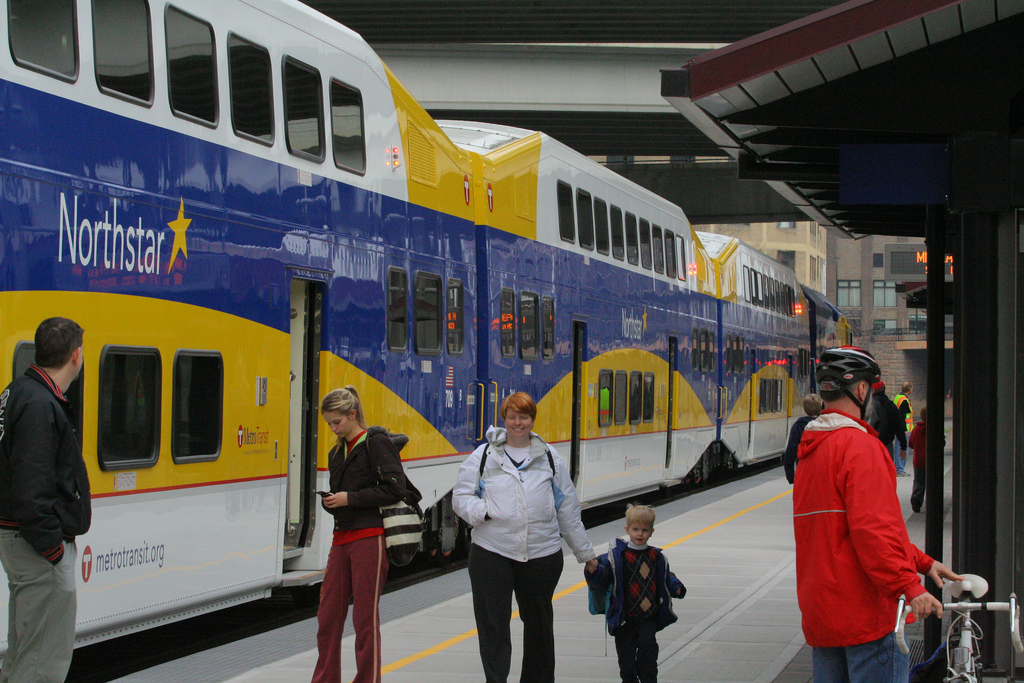
I disagree. I think we could bring back the old service with no additional subsidy and extend the line to St. Cloud for about one-tenth the cost of the MnDOT plan. Furthermore, the implication is that only these two things could possibly improve the service, but there are many small tweaks we have yet to explore.
We’ve Tried Nothing and We’re All Out of Ideas
I made a laundry list of potential improvements big and small back in 2022, and I think it’s a good idea to revisit some of them. While the thrust of my points remains true, they need updating to reflect a number of changes both in local transit patterns and the world at large. I’ve also learned a lot about how both the Northstar and metro area governance work and better developed my ideas on how transit in the Twin Cities should be structured. Oh, and I obtained a copy of the original Northstar service agreement between the Metropolitan Council and BNSF Railway from 2007, which I’ll just call “the agreement.”
I’m not going to pretend any of these will transform service overnight, but given enough time, I think they can change the calculus of whether the Northstar is worth keeping.
Increase Frequency
Despite a 200% increase in service since the last time I wrote about this, we’re still only at about 56% of where we were before COVID-19, and we’re still tied with the Altamont Corridor Express (ACE) in California for the worst schedule of any commuter rail system in the U.S. The thing is, we don’t need to be. The agreement hasn’t changed. It still allows for six daily round trips on the corridor, provided they “arrive at the terminal station between 6 a.m. and 9 a.m. Central time or between 4:30 p.m. and 7:30 p.m. Central time,” aren’t scheduled more than half-hourly and don’t meet on the final lead-up to Target Field Station.
The current schedule is set up in such a way as to only use two trainsets, and therefore two crews, to keep costs down. The pre-COVID schedule used four. Working within those constraints, here’s what a condensed timetable of “restored” service could look like.
| Direction | Big Lake | Target Field |
| South | 5:08 AM | 6:00 AM |
| South | 5:53 AM | 6:45 AM |
| North | 7:07 AM | 6:15 AM |
| South | 7:22 AM | 8:14 AM |
| North | 7:53 AM | 7:01 AM |
| South | 8:08 AM | 9:00 AM |
| North | 4:30 PM | 3:38 PM |
| North | 5:15 PM | 4:23PM |
| South | 4:45 PM | 5:37 PM |
| North | 6:44 PM | 5:52 PM |
| South | 5:31 PM | 6:23 PM |
| North | 7:30 PM | 6:38 PM |
I’ll admit, the 90-minute gaps in the middle of rush hour aren’t ideal, but this still provides more trips than the old schedule and a wider service span than the train has ever had. This while staying within the above requirements. That said, I’d rather keep the current schedule and add a couple of midday frequencies, which may be possible.
The agreement isn’t set in stone. So long as train length doesn’t exceed 10 cars — which I think is a liability thing — the Met Council can propose any change they want. BNSF is under no obligation to approve, conditionally or unconditionally, but I don’t think in this case they’d object, as it doesn’t increase the total number of permitted trains. Back when we had weekend service — which we should bring back — it was theoretically “one morning, one midday and one afternoon/evening train, as described In the Service Plan.”
Maybe I’m splitting hairs, but this isn’t how I’d describe the Saturday schedule. It seems more like “one midday, one afternoon, one evening.”
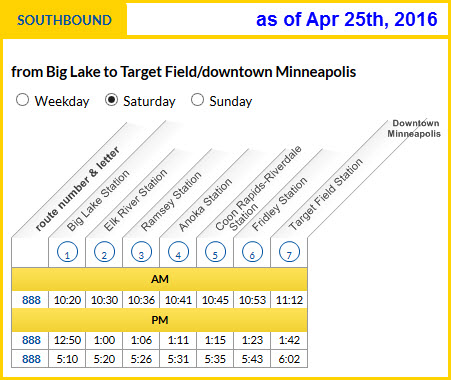
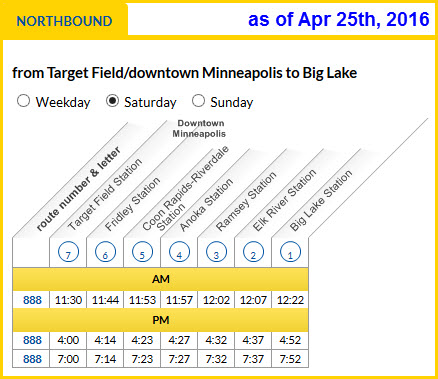
Furthermore, I’d argue that even 2019 service levels are short of where we could be. The agreement leaves room for plenty more special event trains than the 46 we ran last year to Vikings (and some Twins) games. The two hard requirements are that the train can’t meet any other Northstar train between Target Field and University Junction (the wye just across the river where the route turns north) and that Metro Transit give BNSF 20 days’ notice of its intent to offer the special service. BNSF still has discretion to modify or reject proposals based on traffic levels, but I can’t see why they wouldn’t agree to at least one per day. It’s pretty hard to argue that an extra train would cause problems on one day but not another.
Special trains have even run to Union Depot in downtown St. Paul in the past, which opens up many more possibilities. Any sports game at the downtown stadiums (sorry, Loons fans) could all have their own trains. Actually, why stop there? Why not concerts or other special events like Holidazzle, Depot Days or Taste of Minnesota? The high capacity of the Northstar trainsets would really shine in State Fair service; all we need is a platform.
I emphasize event service because events overload our car infrastructure to a greater degree than rush hour traffic. An hour’s commute is one thing, but an hour just to get out of a parking ramp? That’s a whole different ballpark! Assuming people enjoy the trip, it’s likely they’ll use it again to go to other events or anything else for which they could use transit, slowly attracting riders old and new.
Despite the pandemic, the Northstar’s ridership correlates incredibly well with vehicle revenue hours. The reduced service and therefore ridership mean the required subsidy is about the same as it was before 2020. Conversely, if these changes ever get implemented, I think there’s a good chance we could reach the old ridership numbers again without any additional funding.
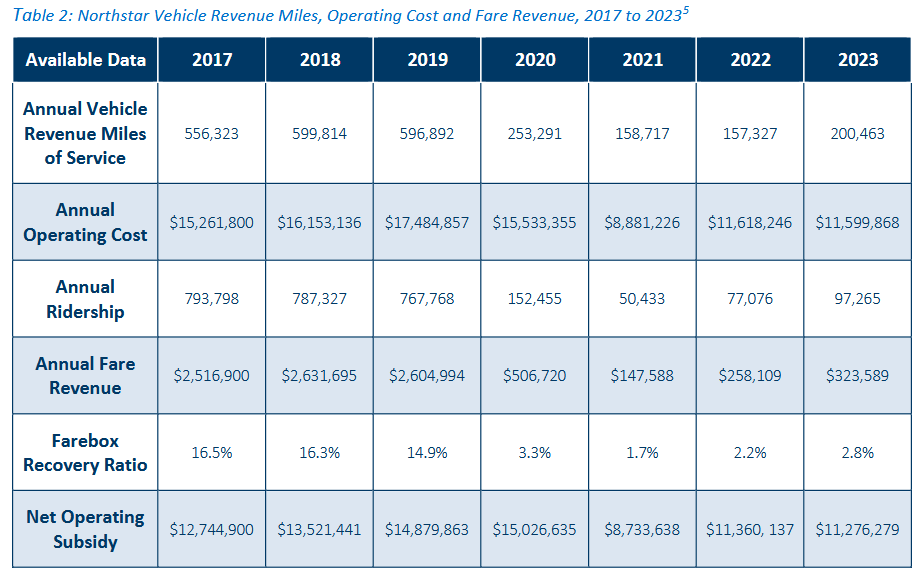
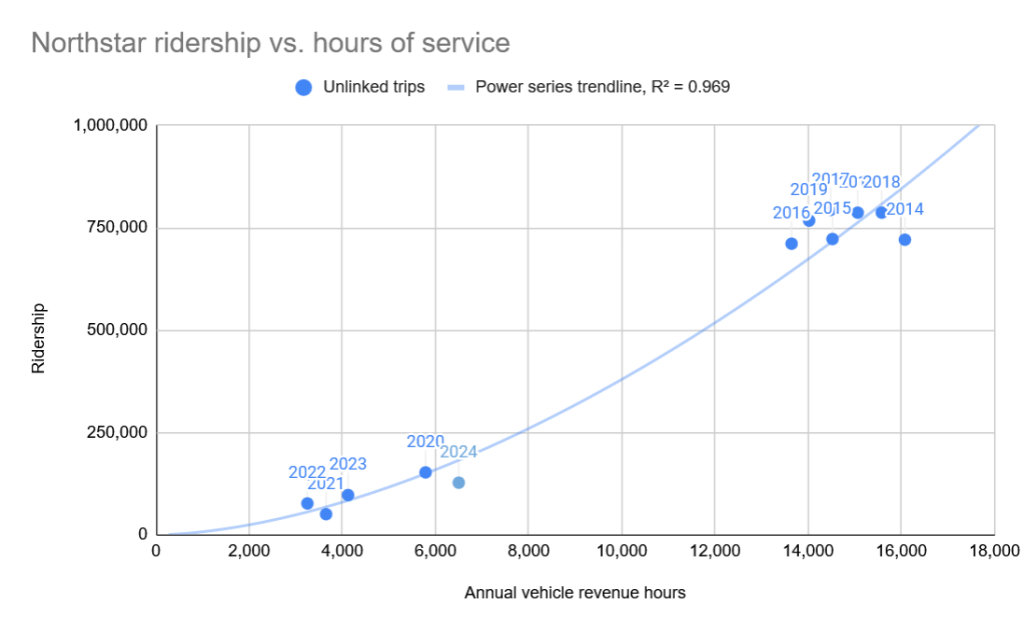
Northstar’s Place
I’m going to stop for a moment and explain what I like to call “Ian’s Hierarchy of Transit” as it adds important context to the next two sections. Like almost everything else in life, a mode of transit that excels at one thing often lacks in another. Fast routes have less-dense stop spacing and lower overall capacity, and vice versa. As such, one can think of these modes as falling on a spectrum. In the Twin Cities, ours looks something like this.
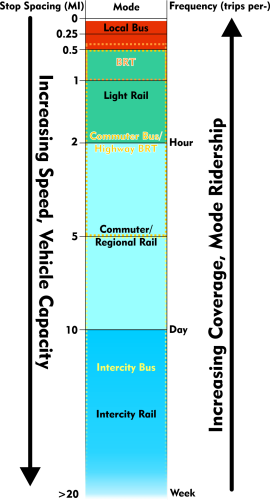
The Metro Transit system is a little disorganized, in my opinion, and unnecessarily complex. We keep trying to right-size every transit project, and in the process add new modes with increasingly meaningless terminology — but that’s not important right now. What matters is how the Northstar fits in. Its existence is more than just shuffling downtown commuters and event-goers. Regional rail is a link between intercity, regional, and local travel. Instead of driving downtown to take a train across the country, or just driving the whole way, people can leave their cars at home. They can bike or bus to the Northstar, and then transfer to Amtrak to go wherever their heart desires.
Add an Amtrak Stop to the Line
In my last Northstar article, I talked about Anoka’s petition to make their stop an Empire Builder stop as well, and that’s still a good idea. Since then, Amtrak’s Borealis has started running between St. Paul and Chicago, with the Wisconsin Department of Transportation (WisDOT), of all things, studying an extension to Minneapolis, which would also use Target Field Station. Below is an estimate of how the train would match the above schedule, given a historical 45-minute trip between the two downtowns.
| Northstar | Borealis | |
| East | Arr. 9:00 AM | Dep. 11:05 AM |
| West | Dep. 6:38 PM | Arr. 7:15 PM |
So the schedule would need some adjusting. Thankfully, we’ll have an opportunity to do just that when Wisconsin adds another Hiawatha trip next year, which would allow MnDOT to align the schedule with Northstar service, if it’s still around.
Add Additional Bus Service
Due to the geography and built environment of the Northstar corridor, I think it could benefit from more feeder lines. Most stations are hemmed in on at least one side by the Mississippi River, U.S. Highway 10 or both. Metro Transit’s Network Now plan presents some new opportunities for this, like the proposed new Route 802, the restored Route 860 or possibly having the Coon Rapids station within the proposed Metro micro zone. Long term, with the right feeder network and higher frequency, the train could mostly replace Routes 766, 768, 850 and 852. The biggest opportunity, however, is with the Key Express Network, a group of enhanced suburban commuter routes that will provide both bidirectional and midday service.
At its core, the Metro Transit network is a hub-and-spoke system, with three main hubs — both downtowns and the Mall of America/airport complex — as well as many smaller ones out in the suburbs, such as Sun Ray, Northtown, Maplewood and Southdale malls. These and other locations provide central points from which the routes radiate out, sometimes from hub to hub, but rarely offering skip-hub service. Route 355 is the only route I can think of that does this. In short, while routes often run from the edges of the system to the center, or around an edge, we don’t have routes that start at an edge, pierce through the center and come out the other side. I’m not sure if Metro Transit has any plan for the Key Express Network beyond consolidating the suburban commuter buses, but I would hope this sort of use case is considered.
Regional rail is ideal for this edge-to-edge travel: It has a higher top speed than a coach bus at 79 mph versus 65 mph. The agreement has on-time performance bonuses, and Northstar trains don’t get stuck in traffic the way buses and cars do. Lacking that, express buses make an OK substitute. The walk from Target Field Station to the Marq2 corridor makes for an inconvenient transfer, but a trip from Big Lake to, say, Burnsville Heart of the City is possible in just over an hour and a half. Considering driving takes about an hour with no traffic, that’s respectable!
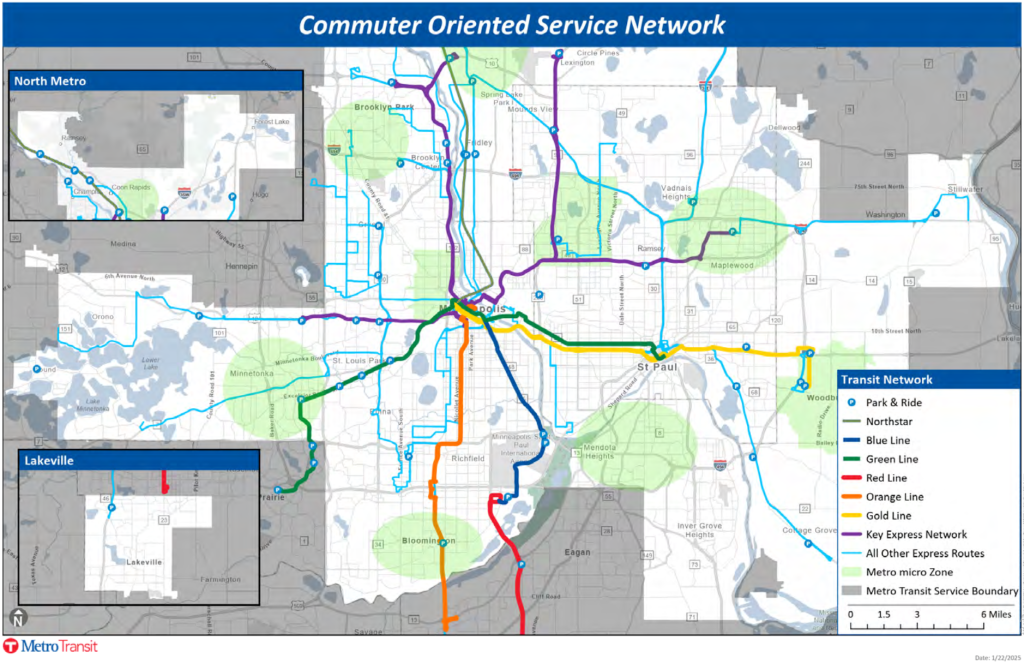
Minneapolis’s lack of a central multimodal hub like St. Paul’s is an issue we’ll need to reckon with someday, but right now we have a hard enough time just building bus lanes.
Build More Transit-Oriented Development
We’re now five years on from the start of the pandemic, and at this point it’s safe to say that, despite the president’s and our governor’s best efforts, the 9-to-5 office commute isn’t coming back to the level it once was. So I’ll ask: Do we really need six-acre parking lots and/or expensive ramps at almost every station? Why not sell some of it off for redevelopment? That ought to make a dent in Northstar’s expenses. Metro Transit is looking to divest itself of many of its other park-and-rides for the same reason.
The east lot at the Fridley station was redeveloped about five years ago, giving us an idea of what this could look like. As you can see, there are still plenty of open parking spaces.
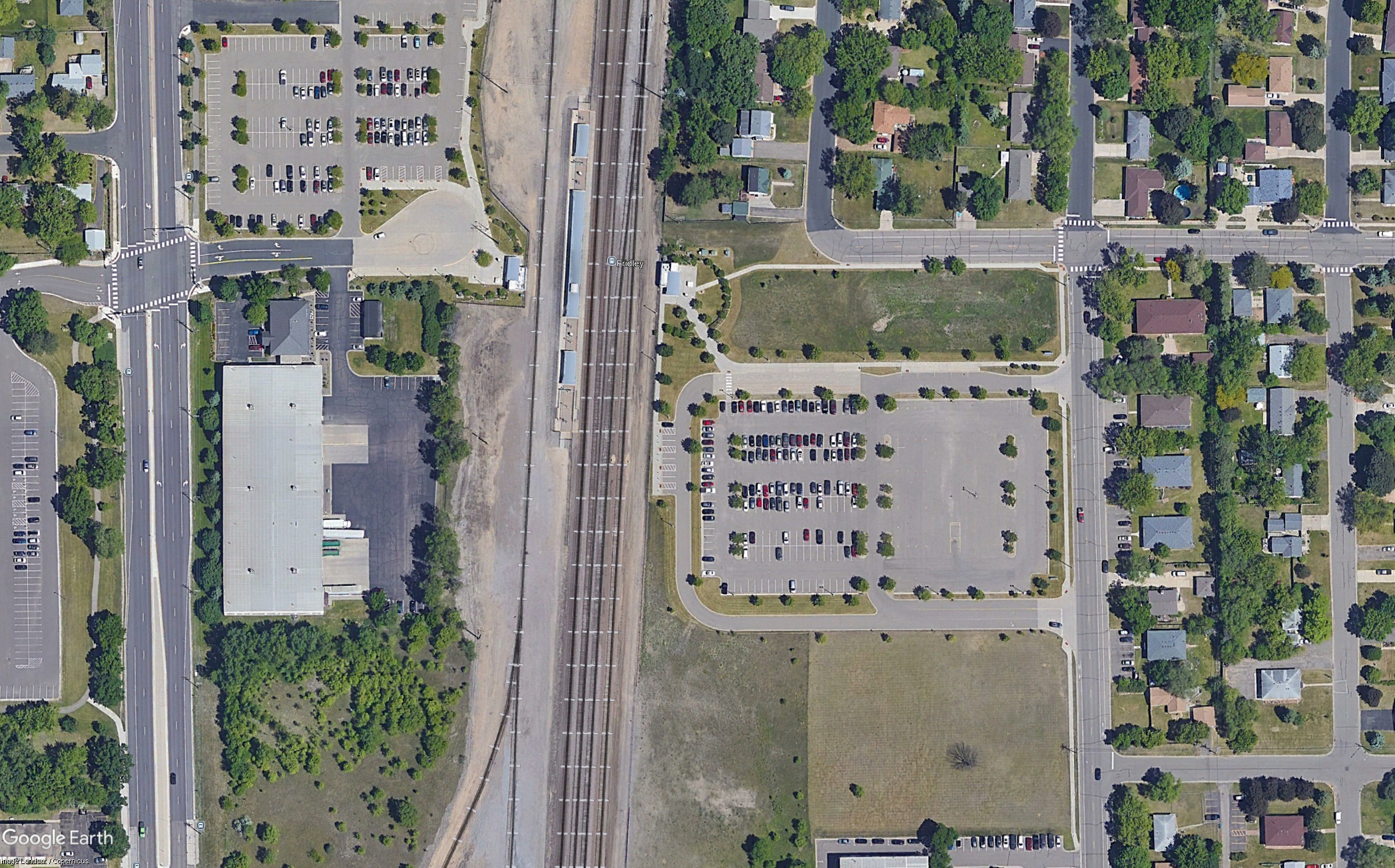

Do Literally Nothing
Apparently I was a little overzealous last time when I suggested how these smaller changes could snowball into larger ones. So, let’s try something more MnDOT’s speed: Just do nothing! OK, that’s not true. They’ll need to do one thing, which is build the Northern Lights Express (NLX), but that’s a project they seem more keen on — or at least they aren’t actively hostile toward it.
Both projects have a couple of large infrastructure improvements in common: additional main line track between the control points (CPs) at Stadium and Van Buren and those at Interstate and Coon Creek. As these projects were studied independently, they both were done using current conditions as a baseline. Only nerds like me who bury themselves in these documents for fun would pick up on efficiencies like this. Apparently even MnDOT wasn’t aware of this, as their most recent study lists the wrong segment of track as one that NLX would cover, while omitting the two that actually overlap. Needless to say, if it gets built under one project, we won’t need to build it again for the other. Northstar will even get a free infill station at Foley Boulevard!
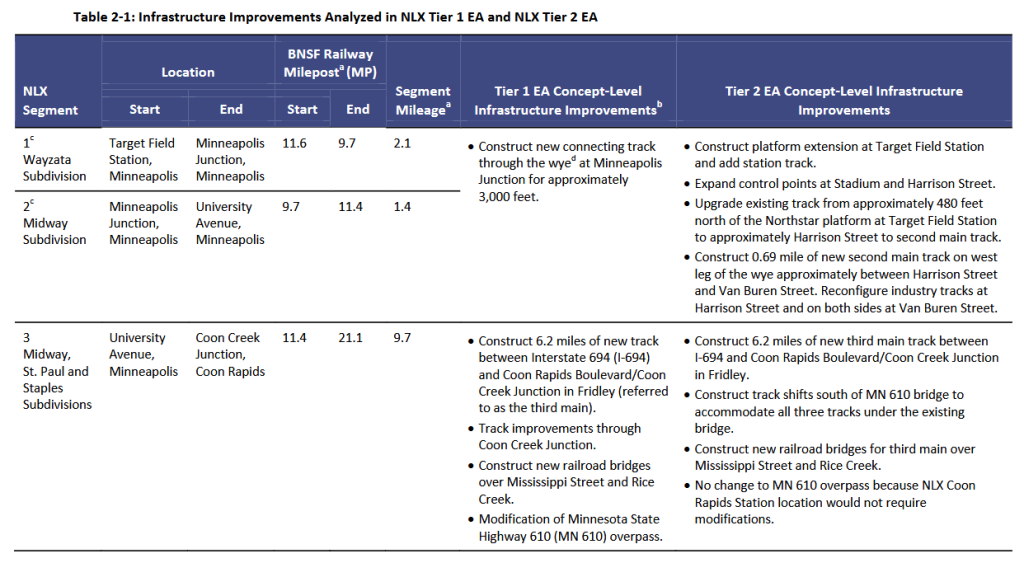
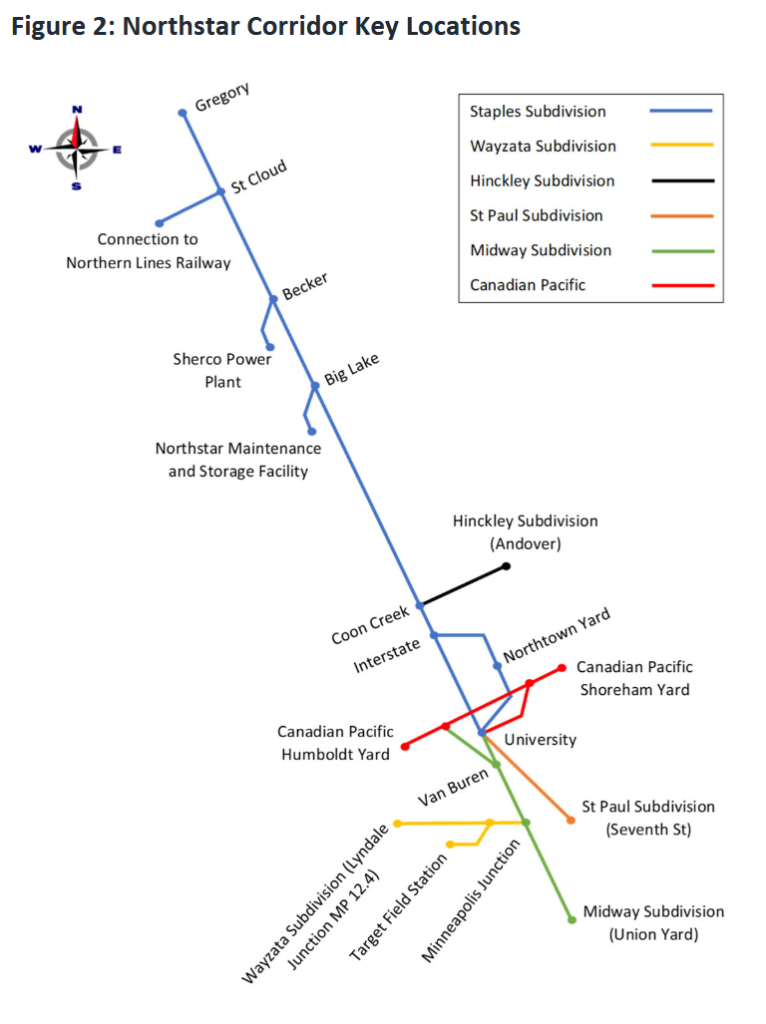
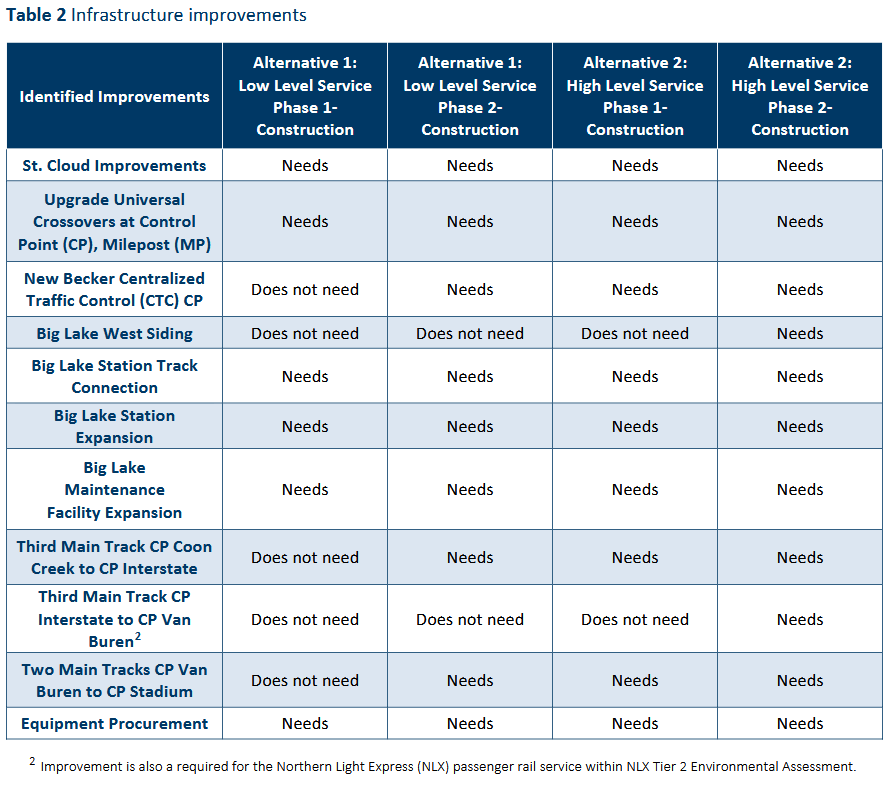
Actually, why do we need to build six miles of new track here anyway? The minimum service alternative just takes two existing round trips and extends them to St. Cloud. There’s no additional service east of Big Lake! I hate to come down on public sector workers at a time like this, but I blame MnDOT. One could just write the above off as a gaffe, but Mike Hicks — a fellow transit blogger and former Streets.mn contributor — recently dug into all the other ways the most recent study is flawed. It’s based on bad rail traffic estimates where they seemingly take BNSF at their word. The Gulf Breeze Saga proved this is always a bad idea.
Either they don’t have the resources to do this properly — in which case Amtrak should just do our rail studies, as with the Borealis — or they have it in for the Northstar. Considering they somehow managed to cram “kill Northstar, with no alternatives” into a study that’s objectively about expanding passenger rail service between the Twin Cities and Fargo, I’m inclined to think it’s the latter.
Did you know Amtrak is currently working to bring all of its stations into ADA compliance? Did you also know they haven’t started St. Cloud yet? There could be some cost savings by lumping these two projects together. Equipment costs are eliminated by slightly adjusting the timetable I came up with earlier. No new equipment means no expansion of the maintenance facility, either.
| Direction | St. Cloud | Big Lake | Target Field |
| South | 5:08 AM | 6:00 AM | |
| South | 5:53 AM | 6:45 AM | |
| North | 7:33 AM | 7:07 AM | 6:15 AM |
| South | 7:22 AM | 8:14 AM | |
| North | 7:53 AM | 7:01 AM | |
| South | 7:48 AM | 8:19 AM | 9:11 AM |
| North | 3:59 PM | 4:33 PM | 3:41 PM |
| North | 5:15 PM | 4:23PM | |
| South | 4:14 PM | 4:45 PM | 5:37 PM |
| North | 6:44 PM | 5:52 PM | |
| South | 5:31 PM | 6:23 PM | |
| North | 7:30 PM | 6:38 PM |
So that just leaves:
- Some of the St. Cloud improvements.
- Upgrading the universal crossover at milepost 66.
- New control point at Becker.
- West siding connection and new platform at Big Lake.
The cost of which, according to the 2020 study, is somewhere between $17.6 million and $44.3 million. Before you accuse me of cherry-picking, the more recent one is missing an itemized cost breakdown. MnDOT, where is this “Attachment 1” you speak of?
Extrapolating, this means the high-service alternative with nine round trips — four continuing to St. Cloud — would cost an additional $55.4 million. I’d imagine this massive reduction in scope would lead to time savings, although being contingent on other projects and agencies could easily cancel that out.
It’s Not Over Till It’s Over
Despite what you may have heard, the end of the Northstar is still a ways off. At the least, the agreement requires six months’ notice from the Met Council to BNSF before service can be terminated. Before that point, an agreement needs to be made with the Federal Transit Administration (FTA) and other parties with respect to disposition and repayment. It’s estimated that the amount owed to the FTA is in the range of $10.6 million to $161.9 million. The low end is a proportional refund for the sale price of the equipment, and the high end is the full federal share of the project. Given the current administration’s, shall we say, thriftiness, I don’t see them taking anything less than the full amount. Even if they do, with the replacement bus estimated to cost $2 million a year to run, it will likely take five to 10 years before it actually saves any money.
That assumes it even gets to that point. I reached out to the mayors of the towns along the line, and those of Elk River, Anoka and Fridley all replied expressing frustration with how things have played out.
Anoka Mayor Erik Skogquist had the harshest words:
The City of Anoka believes Northstar to have been a huge positive in our community and wishes it to continue. During its height it provided decent service and was heavily used by commuters and event goers. However, with the pandemic and then Anoka County and now Met Council limiting funding and the amount of trains and service options, this has created a system with no flexibility and poor service which has continued to make it unusable for most people. Flexibility for the user is what would allow more transit use. This is also true of the disinvestment in bus services. Less buses and trains means less users, and less users means less buses and trains. To have a great transit system requires investment and stable and dependable service. Many metropolitan areas have done a good job building at operating these systems to make sure they work, such as Denver, but the Twin Cities has been very sporadic in its construction and poor in its execution for decades.
Elk River Mayor John Dietz expressed desire for a replacement bus should the service go away, but Metro Transit is already absolving themselves of anything outside the seven-county metro area.
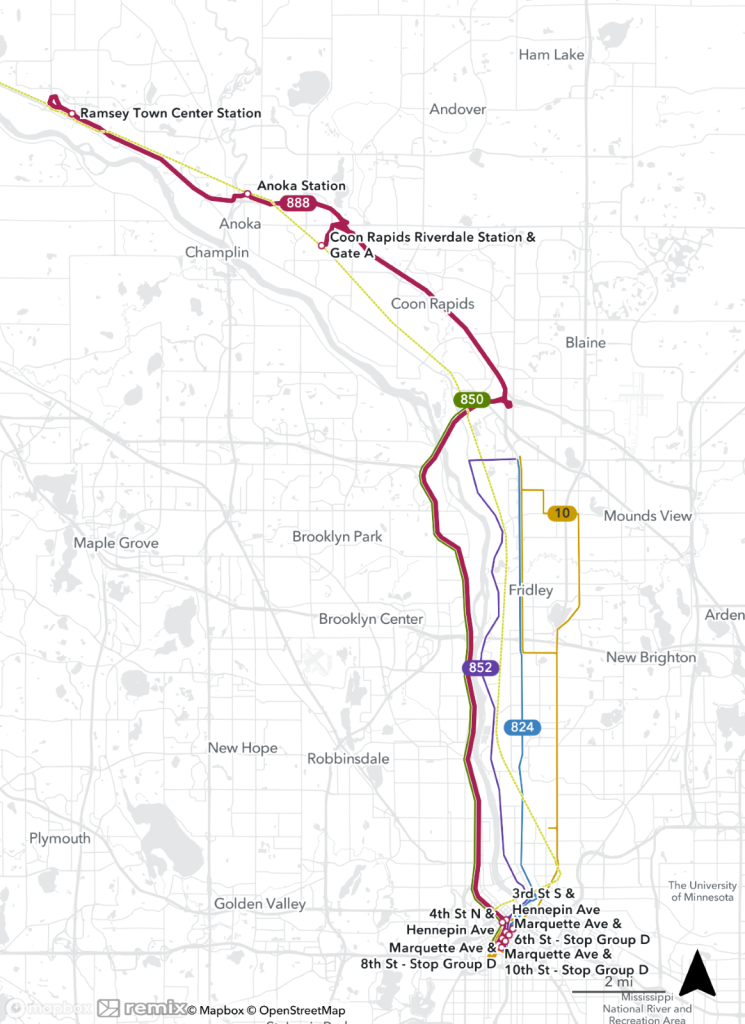
The final stakeholders are you, me and the common flea. Metro Transit is currently running a survey and will host public input sessions about a possible replacement bus, shown above. The proposed schedule is every 30 minutes during rush hour (6 to 8:30 a.m. and 4 to 6:30 p.m.) and every 60 minutes midday (8:30 a.m. to 4 p.m.). Route 852 would shift to serve Fridley. I’ll admit, this is decent service for a suburban express bus. I just wish it didn’t come at the cost of eliminating the Northstar. It would cut people off from public transit and take longer, and despite the higher frequency is projected to have much lower ridership. There’s no word on what would happen to the Northstar Link bus to St. Cloud. Since there will be nothing to link to, my guess is that would also be eliminated.
Overall, eliminating the Northstar would be a net negative for transit in the region. Although the line’s current usefulness is questionable, Metro Transit could take action today to increase frequency if they wanted to. Combined with continued investment both on and around the line, the Northstar could one day become the backbone of transit for the north metro and into central Minnesota.
I hope for a day when the conversation changes from “Should we keep it?” to “Where else should it run?”
